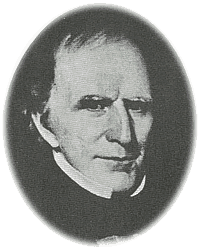Difference between revisions of "William Cabell, Jr."
m |
|||
| Line 57: | Line 57: | ||
Cabell married twice. In 1795 he married his cousin Elizabeth Cabell, with whom he had three children. Four years after Elizabeth's death in 1801, Cabell married Agnes Gamble (or Agnes S. B. Cabell), with whom he had eight children. <ref> Ibid. </ref> | Cabell married twice. In 1795 he married his cousin Elizabeth Cabell, with whom he had three children. Four years after Elizabeth's death in 1801, Cabell married Agnes Gamble (or Agnes S. B. Cabell), with whom he had eight children. <ref> Ibid. </ref> | ||
| − | |||
==See also== | ==See also== | ||
Revision as of 08:51, 23 February 2017
| William H. Cabell | |
| Representative for Amherst County in the Virginia House of Delegates | |
| In office | |
| 1796, 1798-1799, 1802-1805 | |
| 14th Governor of Virginia | |
| In office | |
| 1805-1808 | |
| Preceded by | John Page |
| Succeeded by | John Tyler, Sr. |
| Circuit Court Judge | |
| In office | |
| 1808-1811 | |
| Judge for the Virginia Supreme Court of Appeals | |
| In office | |
| 1811-1851 | |
| 6th Chief Justice of Virginia | |
| In office | |
| 1842-1851 | |
| Preceded by | Henry St. George Tucker, Sr. |
| Succeeded by | John J. Allen |
| Personal details | |
| Born | December 16, 1772 |
| Cumberland County, Virginia | |
| Died | January 12, 1853 |
| Richmond, Virginia | |
| Resting place | Shockoe Hill Cemetery |
| Residence(s) | "Montevideo" in Buckingham County, Virginia |
| Education | Hampton Sydney College; The College of William & Mary |
| Alma mater | The College of William & Mary |
| Profession | lawyer, judge, politician |
| Spouse(s) | Elizabeth Cabell, Agnes Gamble |
| Relatives | Joseph Carrington Cabell |
William H. Cabell was born on December 16, 1772, at "Boston Hill" in Cumberland County, Virginia, to Colonel Nicholas Cabell and Hannah Carrington Cabell. Cabell attended Hampton Sydney College in 1785 before studying law under George Wythe at the College of William & Mary. In 1793 Wythe moved to Richmond and Cabell followed in order to complete his legal studies. In 1794 Cabell received his license to practice law. [1]
During three different sessions (1796, 1798-1799, 1802-1805), Cabell represented Amherst County in the Virginia House of Delegates. He was proud of voting for the Virginia Resolutions (declaring the Alien & Sedition Acts unconstitutional) as well as voting for Thomas Jefferson in the Electoral College. [2]
In 1805 Cabell became the fourteenth governor of Virginia and served the maximum three one-year terms. His time as governor was "marked by Aaron Burr's trial in Richmond for alleged treason, by the celebration of Virginia's sesquicentennial at Jamestown, and by the United States prohibtion of importation of slaves from Africa." [3] Cabell also dealt with rioting and issues of national defense during the Chesapeake Affair of 1807, the incident that lead to Jefferson's Embargo Act. [4]
However, Cabell "was committed to a career in law" and his true desire was to become a judge of the General Court. In 1808 Cabell was appointed to the General Court for the circuit including Richmond and counties along the James River. In 1811 he took a seat on the Virginia Supreme Court of Appeals. In 1842 Cabell became the sixth chief justice of Virginia when the legislature "elevated him to president of the court." [5] He and Spencer Roane worked to defend State's Rights and "fought as 'Old Republicans' against the federal government" in Martin v. Hunter's Lessee. [6] Cabell remained Chief Justice until he retired in 1851. [7]
Cabell also served on the board of commissioners in 1818 "to determine the site and formulate a plan for funding the University of Virginia." And from 1809 until 1830 he served as a trustee of Hampden Sydney College. [8]
Cabell was known for being practical and down-to-earth, giving "little credence to flowery rhetoric and courtroom showmanship" in favor of a common-sense approach. When not on the bench, Cabell resided at his Buckingham County plantation, "Montevideo," on the James River. [9] On January 12, 1853, Cabell passed away in his Richmond home and was buried in the Shockoe Hill Cemetery. [10]
Cabell married twice. In 1795 he married his cousin Elizabeth Cabell, with whom he had three children. Four years after Elizabeth's death in 1801, Cabell married Agnes Gamble (or Agnes S. B. Cabell), with whom he had eight children. [11]
See also
References
- ↑ American National Biography Online, s.v. "Cabell, William H.," by F. Thornton Miller, accessed March 2, 2016.
- ↑ Ibid.
- ↑ "Virginia Governor William Henry Cabell," National Governors Association: The Collective Voice of the Nation's Governors, accessed March 2, 2016.
- ↑ Edwin M. Gaines, "The Chesapeake Affair: Virginians Mobilize to Defend National Honor," The Virginia Magazine of History and Biography, Vol. 64, No. 2 (Apr., 1956), pp. 131-142.
- ↑ Miller, "Cabell, William H."
- ↑ "William H. Cabell (1772-1853)," Albert and Shirley Small Special Collections Library (Rector and Visitors of the University of Virginia, 2016), accessed March 1, 2016.
- ↑ Miller, "Cabell, William H."
- ↑ Ibid.
- ↑ Miller, "Cabell, William H.;" "William H. Cabell (1772-1853)."
- ↑ "Virginia Governor William Henry Cabell."
- ↑ Ibid.
